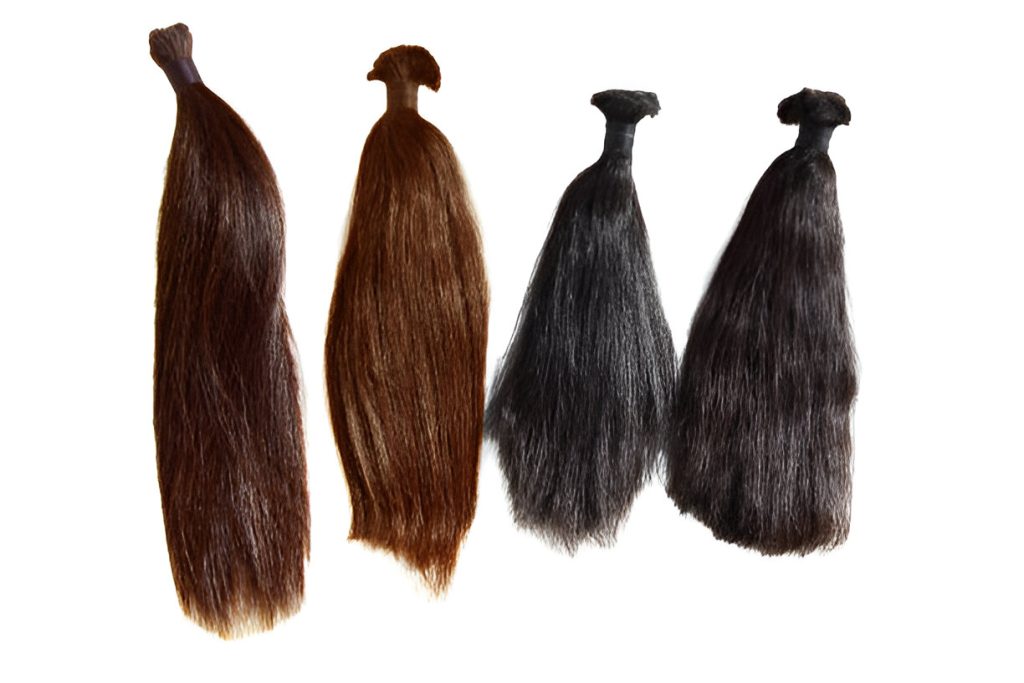
Human Hair vs. Synthetic Hair Extensions: Understanding the Key Differences
Hair extensions have become a popular solution for those looking to add length, volume, or even a touch of color to their natural hair. Whether you’re aiming for a sleek, polished look or voluminous waves, extensions are a game-changer. But when it comes to choosing the right type of hair extension, the decision often boils down to two main options: human hair and synthetic hair. Both have their pros and cons, and understanding the differences can help you make the best choice for your hair goals.
1. Quality and Appearance
Human Hair
As the name suggests, human hair extensions are made from real human hair. This makes them incredibly natural in both appearance and texture. Human hair has the same cuticle alignment and movement as natural hair, allowing it to blend seamlessly with your own hair, whether you’re looking for a sleek, straight style or voluminous curls.
- Texture: The texture of human hair extensions is versatile, allowing them to be styled with heat tools (such as flat irons or curling wands). Human hair extensions come in various textures, including straight, wavy, and curly, offering a more personalized fit for different hair types.
- Appearance: The natural sheen of human hair is hard to replicate with synthetic fibers. It’s more vibrant and can be styled to reflect your natural hair’s shine and color.
Synthetic Hair
Synthetic hair extensions are made from artificial fibers, typically made from polyester, acrylic, or nylon. These fibers are designed to mimic the look and feel of human hair, but they don’t offer the same natural movement or texture.
- Texture: Synthetic hair comes pre-styled, which means it holds its shape and style without the need for heat styling. While this can be convenient for some, it also limits your styling options. For example, you can’t curl or straighten synthetic hair like you can with human hair. It also tends to be more prone to tangling and can feel less natural when compared to human hair.
- Appearance: Synthetic hair has a shinier, more artificial look, which may be noticeable under certain lighting conditions. However, advances in synthetic fiber technology have made some synthetic extensions look impressively close to real human hair.
2. Maintenance and Durability
Human Hair
Human hair extensions are a long-term investment. With proper care, they can last from several months to even years, depending on how frequently they are worn and maintained.
- Maintenance: Human hair extensions require regular washing, conditioning, and detangling to keep them looking their best. You can also style them with heat tools, though it’s important to use heat protectants to prevent damage over time.
- Durability: These extensions are durable and can withstand regular styling and washing. Because they are made from real hair, they tend to look better and feel more natural the longer they’re worn.
Synthetic Hair
Synthetic hair extensions, on the other hand, are more affordable but have a shorter lifespan compared to human hair. They generally last between 4 to 6 months, depending on the quality and how often they are worn.
- Maintenance: Synthetic hair requires minimal maintenance, as it doesn’t need to be washed as frequently as human hair. However, it can be challenging to remove tangles without damaging the fibers. Additionally, you can’t use heat styling tools on most synthetic hair extensions (unless they are specifically labeled “heat-resistant”).
- Durability: Synthetic extensions are less durable than human hair extensions. Over time, the fibers can lose their shine, become brittle, or start to frizz. Extreme temperatures (heat or cold) can damage the fibers, making them less flexible than natural hair.
3. Cost
Human Hair
Because of the high-quality nature of human hair, extensions made from real human hair tend to be more expensive. The cost varies depending on factors like the length, texture, and origin of the hair. Higher-quality human hair extensions, such as Remy hair, will typically cost more due to the meticulous processing involved in maintaining the cuticle alignment.
- Investment: Human hair extensions are a more significant upfront investment, but they often offer better value in the long run due to their longevity and styling versatility.
Synthetic Hair
Synthetic hair extensions are typically much more affordable than human hair extensions. This makes them an attractive option for those on a budget or those who want to experiment with different styles without committing to a high-cost product.
- Affordable: While synthetic hair is much cheaper upfront, it may need to be replaced more frequently, which can add up over time.
4. Styling Flexibility
Human Hair
One of the standout benefits of human hair extensions is their versatility. You can treat them just like your own hair—color them, cut them, curl them, straighten them, or use styling products. Human hair extensions offer the most natural look and feel when styled, and they blend well with natural hair textures.
Synthetic Hair
Synthetic hair extensions are much less flexible when it comes to styling. Most synthetic hair cannot be styled with heat tools, and it comes pre-set in a specific style (e.g., straight, curly). If you like variety in your looks and frequently change your hairstyle, synthetic hair extensions might not be the best option for you.
5. Environmental Impact
Human Hair
Human hair extensions are biodegradable, meaning they break down naturally over time. While the production of human hair extensions does involve human labor and resources, it’s generally considered a more eco-friendly option compared to synthetic materials, especially if sourced ethically.
Synthetic Hair
Synthetic hair is made from plastic-based fibers, which are not biodegradable and can contribute to environmental waste. Additionally, the production of synthetic fibers involves petroleum-based chemicals, which may have a larger carbon footprint than human hair. For eco-conscious consumers, this may be a significant drawback.
6. Comfort and Weight
Human Hair
Human hair extensions are generally lighter and more comfortable to wear for extended periods. Since they are made from real hair, they feel more natural and blend seamlessly with your own hair.
Synthetic Hair
Synthetic hair extensions tend to be heavier and can feel bulkier. While the weight might not be noticeable at first, extended wear can lead to discomfort, especially if the synthetic fibers are thick or heavy. Additionally, synthetic hair may feel stiffer and less soft to the touch than natural hair.
7. Suitability for Different Lifestyles
Human Hair
Ideal for people who wear extensions regularly and want something that looks, feels, and behaves like their own natural hair. They are also better suited for individuals who want to style their extensions with heat tools or who are looking for a long-term investment.
Synthetic Hair
Best suited for those who want a temporary, low-maintenance option or who are on a budget. If you’re looking for a quick and easy solution for a special event, synthetic hair extensions can be a great option. However, if you plan to wear extensions frequently or need something for everyday use, human hair may be the better choice.
Conclusion
Choosing between human hair and synthetic hair extensions ultimately depends on your personal preferences, budget, and styling needs. If you’re looking for long-lasting, natural-looking extensions that can be styled to your exact specifications, human hair is the clear winner. On the other hand, if you’re on a budget or need an easy, no-fuss option, synthetic hair might be the perfect choice.
Remember, both types have their advantages and drawbacks, so the best option for you will depend on how you plan to wear your extensions and the level of maintenance you’re willing to commit to. Whatever you choose, both human hair and synthetic hair extensions can enhance your look and boost your confidence—it’s all about finding the right fit for your lifestyle.



